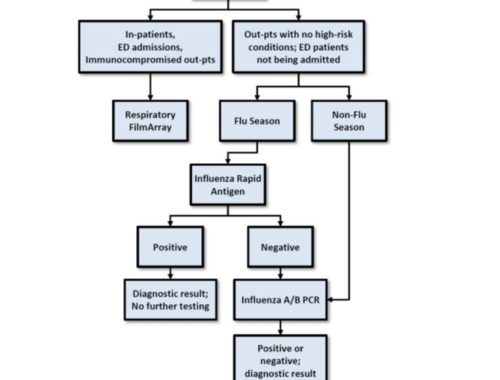Overview
Clinical guidelines no longer recommend serologic testing as a method for the diagnosis of H. pylori infection. Rather than IgG serology testing, other non-invasive testing methods such as H. pylori stool antigen and urea breath tests may be used to both diagnose and monitor response to therapy for H. pylori infection. In anticipation of an increase in stool antigen testing, currently a reference lab send-out test, Spectrum Health Regional Laboratory (SHRL) will be implementing this test as of October 29, 2018. By offering this test in-house, results will typically be available one day faster than present state.
Background
Seroprevalence studies suggest that half of the world’s population is infected with or has been exposed to H. pylori at some point in time, although the majority of those infected are asymptomatically colonized. A minority of infected individuals will develop gastritis and dyspepsia, and a fraction of those will further develop peptic ulcer disease or gastric cancers (adenocarcinoma or mucosa-associated lymphoid tissue (MALT) lymphoma).
Diagnostic Approach
Established clinical guidelines from the American Gastroenterology Association (AGA) and American College of Gastroenterologists (ACG) provide recommendations regarding the preferred testing approach for H. pylori infection1, 2. The gold standard diagnostic remains invasive endoscopy with gastric tissue biopsy followed by bacterial culture, histology, or rapid urease testing. This approach is recommended for higher risk patients (i.e. GI bleeding, sudden weight loss, excessive vomiting, or anemia) or those over the age of 60 for which a clinician may wish to rule out malignancies. The recommended approach for low risk patients includes non-invasive methods such as the urea breath test or stool antigen test. These methods test for active disease and may also be used to monitor response to therapy following completion of an antibiotic treatment regimen. Infected individuals typically remain colonized for life unless effective therapy is used to eradicate the organism.
Serology
H. pylori IgG serologic testing is no longer recommended by clinical guidelines. Due to the high seroprevalence and since antibodies may persist for years beyond acute disease, this test is unable to accurately distinguish between past and current infection. IgG antibodies may be detected 2-3 weeks post-infection, yet they remain elevated for years after eradication. Therefore, serologic testing cannot be used to document eradication post-treatment. Sensitivity (85%) and specificity (79%) are low for both acute and chronic infection, and an increasing number of insurance providers are no longer reimbursing for serologic testing3.
Stool Antigen and Urea Breath Test
AGA and ACG clinical guidelines recommend stool antigen testing or urea breath testing to diagnose active H. pylori infection and guide therapy. Both tests offer high clinical sensitivity and specificity (>95%), and either test may be used to monitor resolution of infection in response to therapy. For both tests, antibiotics and proton pump inhibitors must be discontinued at least 2 to 4 weeks prior to testing to ensure H. pylori viability4.
A drawback of the stool antigen test includes the possibility for two patient visits if the specimen is collected at home. Drawbacks of the urea breath test include increased cost and lack of FDA approval for pediatric patients below the age of 3 years.
Comparison of H. pylori Stool Antigen and Urea Breath Test
| Stool Antigen | Urea Breath Test | |
| Test code | LAB880 | LAB572 |
| Patient expense | $ | $$$ |
| Approved patient population | All ages acceptable | Not available for patients under 3 years of age. |
| Specimen collection | Fresh stool in sterile container or Cary Blair transport media.
May require two patient visits (one to pick up the collection container and another to drop off the specimen). |
Bag of “breath”, transported to Blodgett Hospital for analysis.
Single visit |
| Ease of collection | Non-invasive. Patient can collect at home. | Non-invasive. Patient collects breath at a lab draw site (or provider’s office) before and after drinking a urea solution. |
| Specimen transport temperature | Ambient or refrigerated | Ambient |
| Turnaround time | One day
(testing performed 7 days/week) |
One to three days
(testing performed Monday-Friday) |
Note: if endoscopy with biopsy is performed, tissue may be sent for reference lab testing by culture (Mayo Medical Laboratories, test ID HELIS).
References
- Talley NJ, Vakil N. Practice Parameters Committee of the American College of Gastroenterology: Guidelines for the Management of Dyspepsia. Am J Gastroenterol 2005; 100:2324-2337.
- Chey WD, Wong BCY. American College of Gastroenterology Guideline on the Management of Helicobacter pylori Am J Gastroenterol 2007; 102: 1808-1825.
- Loy CT, Irwig LM, Katelaris PH, Talley NJ. Do commercial serological kits for Helicobacter pylori infection differ in accuracy? A meta-analysis. Am J Gastroenterol 1996;91:1138-114.
- Chey WD, Leontiadis GI, et al. ACG Clinical Guideline: Treatment of Helicobacter pylori Am J Gastroenterol 2017; 112: 212-239.

